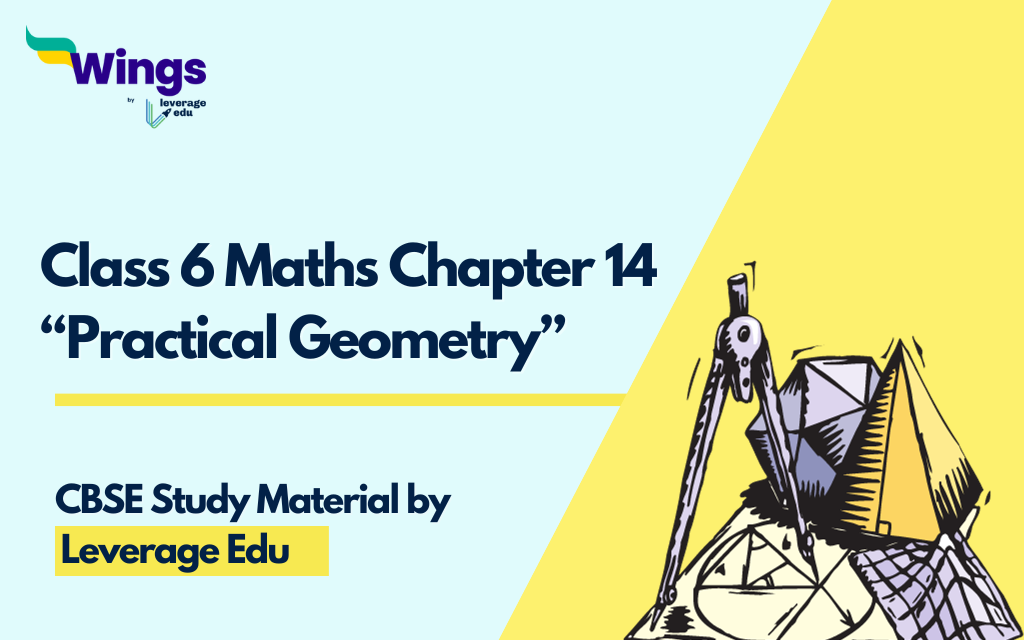In Chapter 14, Practical Geometry – Class 6, students will be introduced to the concepts of Practical Geometry. Students will learn to draw different figures by using different geometrical tools such as rulers, compasses, dividers, protractors, and set squares. The chapter Practical Geometry, Class 6 teaches the concept of angles, and how different angles can be drawn using a compass without actually using the protractor. Here, students come to know the concept of arcs and their intersection for getting a desired angle. Read through for NCERT Maths Practical Geometry Class 6 (Chapter 14) Notes and Solutions PDF.
Contents
Click here to download NCERT Maths Practical Geometry Class 6 Chapter 14 Notes and Solutions PDF
NCERT Maths Practical Geometry Class 6 Chapter 14 Notes – PDF Available
Check the topic-wise notes for NCERT Maths Practical Geometry Class 6 Chapter 14 below. You can also download the PDF of the notes and take a printout to study later when you need quick revision before going to the exam hall.
Top 10 Short Maths Tricks for Complex Problems
Topic 1: Circle
Every point on a circle’s boundary is at an equal distance from its center.
Maths Books for Competitive Exams
BSc Mathematics: Course, Universities and Scope
Topic 2: Line Segment
A line segment has a fixed length with two fixed endpoints.
NCERT Maths Practical Geometry Class 6 Chapter 14 Solutions- Free PDF Download
Below we have provided solutions for NCERT Maths Practical Geometry Class 6 Chapter 14. Go through for answers to some important questions.
Courses and Career Options in Commerce Without Maths in 2023
Exercise 14.1 Solutions
Q 1. Draw a circle of radius 3.2 cm.
Solutions. To draw this circle, open the compass to a length of 3.2 cm on the ruler. Now, from a point ‘O’, swing the compass completely to draw the circle of radius 3.2 cm.
Q 2. Draw a circle and any two of its diameters. If you join the ends of these diameters, what is the figure obtained? What figure is obtained if the diameters are perpendicular to each other? How do you check your answer?
Solutions. We get a rectangular figure by joining the ends of the two diameters of a circle. This can be shown in the figure given below.
When the two diameters are perpendicular to each other, the figure formed on each diagonal is a square.
Top 20 Career Options in Commerce with Maths Stream
Q 3. Draw any circle and mark points A, B and C such that
- A is on the circle.
- B is in the interior of the circle.
- C is in the exterior of the circle
Solutions. The answers are given below.

Exercise 14.2 Solutions
Q 1. Construct a line segment of length 5.6 cm using ruler and compasses.
Solutions. We can draw the line by the following steps:
- Draw a line “l” and mark a point “A” on it.
- Now taking a ruler, put the compass on the point 0 cm of the ruler and extend it to open up to the length of 5.6 cm.
- Place the compass on point A of the line l and make an arc on the line (make sure that the arms of the compass do not shrink from 5.6 cm).
Applied Mathematics and Computation
Exercise 14.3
Q 1. Draw any line segment. Without measuring, construct a copy of.
Solutions. Let’s draw the line segment as given below.
Now, take a compass, place its pointer on point P on the line segment, and stretch it open till point Q. Make sure this length doesn’t change.
Now draw another line “l” and mark a point “A” on it. Place the pointer of the compass on point A and make an arc on the line segment. Mark this point as “B”. This new line segment is the copy of the line segment.
Multiplication and Division Word Problems
Check out Maths Class 6 Notes and Exercise Solutions for other chapters below.
FAQs
Ans: A circle can be drawn by opening the compass to a desired length of the radius of the circle. A point “O” is marked as the center of the circle with a sharp pencil. The pointer (needle) of the compass is placed on point O and turned slowly to draw a circle.
Ans: A line segment can be drawn by marking a point on the line. Then, put the pointer of the compass on the point open the arms of the compass to the desired length, and mark another point on the line. This gives us a line segment of the desired length.
Ans: The differences between a line and a line segment are given below:
-A line has an infinite length while a line segment has a fixed length.
-A line has no end point while a line segment has 2 end points.
This was all about NCERT Maths Practical Geometry Class 6, Chapter 14 in which we studied how to draw different angles and line segments. We also got used to the use of compass, ruler, set square, and protractor in the measuring of lines and angles. Download the NCERT Maths Practical Geometry Class 6 Notes and Exercise Solutions to ace your exam preparations. Follow the CBSE Class 6 Maths Notes for more such chapter notes and important questions and answers for preparation for CBSE Class 6 Maths.
 One app for all your study abroad needs
One app for all your study abroad needs














